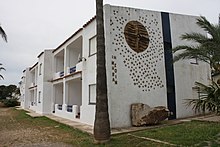Los Alfaques tanker truck accident
The Los Alfaques tanker truck accident was a serious accident in Catalonia ( Spain ) that occurred on July 11, 1978 on the then national road N-340 in the area of the Los Alfaques campsite on the Costa Daurada . 217 people died and more than 400 were injured.
The campsite is still located in the Alcanar-Platja district of the municipality of Alcanar in the Comarca Montsià in the province of Tarragona , just under two kilometers south of the town of Sant Carles de la Ràpita .
the accident
A 38-ton tanker truck from Cisternas Reunidas , loaded with 23 tons of propene , was on its way from the refinery of the state-owned company Enpetrol in Tarragona to a refinery complex in central Spain. Presumably to save the toll that the tanker driver Francisco Ibernón would have had to pay out of his own pocket, he used the N-340 national road south. After 102 kilometers of driving - at kilometer 159.5 - the tank containing the gas burst at around 2:35 p.m. at the level of the boundary wall of the Los Alfaques campsite .
Research into the cause of the accident revealed that the tanker truck was technically overloaded with 23 instead of the prescribed 19 tonnes. A filling-free space was not maintained during filling. In the absence of this space, the liquid gas could not expand. The tank was pushed apart by heating. Because it was also made from a steel that was susceptible to brittle fracture, the tank suddenly failed.
The released liquid gas evaporated immediately, spilled over large parts of the campsite and ignited a few seconds later on the numerous gas stoves. The resulting flame front completely burned a 40 by 60 meter piece of the space between the street and the sea. The gas and burning petrol tanks exploding due to the temperatures generated fueled the fire and stifled quick rescue and extinguishing attempts in the bud. At the campsite, which was clearly overcrowded with 800 people, the driver of the tanker truck and around 140 holidaymakers were killed or died immediately before they could be hospitalized. There were even victims right by the sea, and some of those fleeing into the sea drowned.
Newspapers reported that it took around 45 minutes for the first rescue workers to arrive at the scene of the accident after the explosion. In the meantime, vacationers and residents had already taken care of the emergency patients and some of them were taken to surrounding hospitals in their cars. Emergency forces from all over Spain only gradually arrived at the scene of the accident. The Civil Guard and the military searched the largely destroyed campsite.
The burn injuries were transported to the university hospitals in Barcelona and Madrid and to the La Fe special clinic in Valencia . In the following days and weeks another 70 vacationers died from their injuries. A total of 217 people died, including many Germans as well as French and Belgians. In addition, more than 400 people were injured, some seriously. The people in the caravans or outside suffered severe burns , some of the consequences of which they still suffer today. Those who stayed in stone buildings got off relatively lightly.
In the explosion and the subsequent fire, two thirds of the campsite was destroyed over an area of 300 by 150 meters, with completely burned and almost intact caravans standing next to each other. A discotheque was badly damaged by the blast from the explosion, part of the tank hit a building 300 meters away, the other on a tennis court.
The identification of the victims, some of whom were burned beyond recognition, proved difficult. However, thanks to the work of the identification commission of the German Federal Criminal Police Office , all victims could be identified.
consequences
The disaster led to stricter regulations in the handling of hazardous substances and their transport. As a result of the accident, the transport of dangerous goods through towns is now prohibited in Spain .
Two of those responsible for loading the tanker were sentenced in 1982 to one year in prison for “negligence” ( imprudencia temeraria ). In subsequent civil lawsuits in 1982 and 1983, together with the groups Cisternas Reunidas and Enpetrol, they were obliged to pay damages totaling 2.2 billion pesetas (= 138.23 million euros, not adjusted for inflation).
The campsite was rebuilt and is now operated regularly. To commemorate the accident, there is a wall sculpture on the outer wall of the apartment building with an inscription and a star for each victim.
The story of the misfortune was filmed in 2007 under the title Tarragona - A Paradise in Flames under the direction of Peter Keglevic and first broadcast as a two-parter on September 9 and 10, 2007.
Literature and web links
- El accidente de los Alfaques (2003), on the website of the Grupo Universitario de Investigación Analítica de Riesgos of the University of Saragossa (Spanish)
- Accidente de Los Alfaques Collection of newspaper articles about the accident on the website of a Spanish dangerous goods transport consultancy with further references under the link Bibliografía, normativa y jurisprudencia (Spanish)
- Klaus Ridder : Los Alfaques: A tragedy with consequences (PDF; 203 kB) In: The Hazardous Goods Officer , Issue 3, March 2005
Individual evidence
- ↑ Julia Macher: The disaster of Los Alfaques. In a dangerous goods accident in Spain 30 years ago, 217 vacationers were killed. Deutschlandfunk, July 11, 2008, accessed on August 2, 2017 .
- ↑ grunerjahrzehnte.de
Coordinates: 40 ° 35 ′ 42.8 " N , 0 ° 34 ′ 13.8" E
